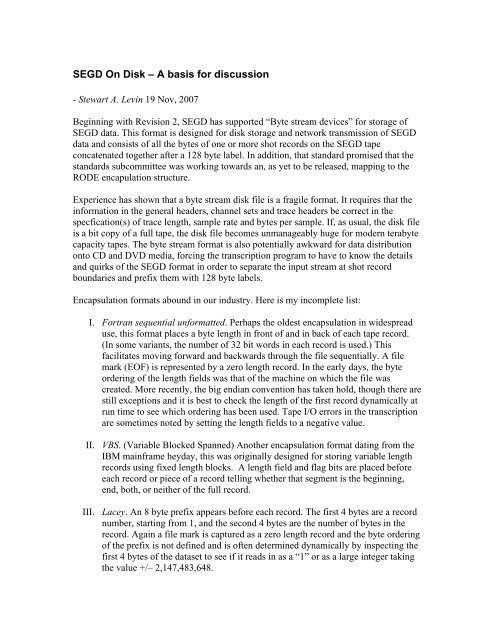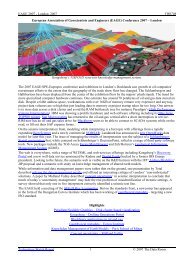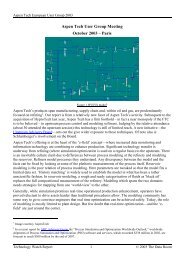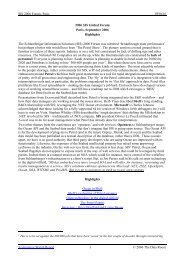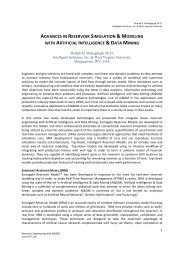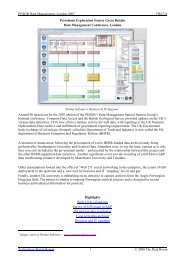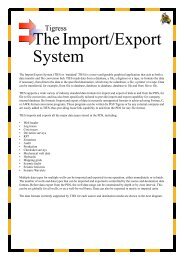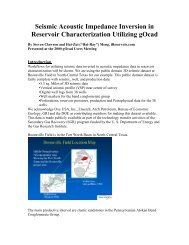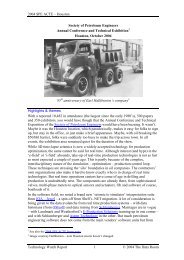SEG-D on disk - a discussion paper
SEG-D on disk - a discussion paper
SEG-D on disk - a discussion paper
You also want an ePaper? Increase the reach of your titles
YUMPU automatically turns print PDFs into web optimized ePapers that Google loves.
<str<strong>on</strong>g>SEG</str<strong>on</strong>g>D On Disk – A basis for discussi<strong>on</strong><br />
- Stewart A. Levin 19 Nov, 2007<br />
Beginning with Revisi<strong>on</strong> 2, <str<strong>on</strong>g>SEG</str<strong>on</strong>g>D has supported “Byte stream devices” for storage of<br />
<str<strong>on</strong>g>SEG</str<strong>on</strong>g>D data. This format is designed for <strong>disk</strong> storage and network transmissi<strong>on</strong> of <str<strong>on</strong>g>SEG</str<strong>on</strong>g>D<br />
data and c<strong>on</strong>sists of all the bytes of <strong>on</strong>e or more shot records <strong>on</strong> the <str<strong>on</strong>g>SEG</str<strong>on</strong>g>D tape<br />
c<strong>on</strong>catenated together after a 128 byte label. In additi<strong>on</strong>, that standard promised that the<br />
standards subcommittee was working towards an, as yet to be released, mapping to the<br />
RODE encapulati<strong>on</strong> structure.<br />
Experience has shown that a byte stream <strong>disk</strong> file is a fragile format. It requires that the<br />
informati<strong>on</strong> in the general headers, channel sets and trace headers be correct in the<br />
specficati<strong>on</strong>(s) of trace length, sample rate and bytes per sample. If, as usual, the <strong>disk</strong> file<br />
is a bit copy of a full tape, the <strong>disk</strong> file becomes unmanageably huge for modern terabyte<br />
capacity tapes. The byte stream format is also potentially awkward for data distributi<strong>on</strong><br />
<strong>on</strong>to CD and DVD media, forcing the transcripti<strong>on</strong> program to have to know the details<br />
and quirks of the <str<strong>on</strong>g>SEG</str<strong>on</strong>g>D format in order to separate the input stream at shot record<br />
boundaries and prefix them with 128 byte labels.<br />
Encapsulati<strong>on</strong> formats abound in our industry. Here is my incomplete list:<br />
I. Fortran sequential unformatted. Perhaps the oldest encapsulati<strong>on</strong> in widespread<br />
use, this format places a byte length in fr<strong>on</strong>t of and in back of each tape record.<br />
(In some variants, the number of 32 bit words in each record is used.) This<br />
facilitates moving forward and backwards through the file sequentially. A file<br />
mark (EOF) is represented by a zero length record. In the early days, the byte<br />
ordering of the length fields was that of the machine <strong>on</strong> which the file was<br />
created. More recently, the big endian c<strong>on</strong>venti<strong>on</strong> has taken hold, though there are<br />
still excepti<strong>on</strong>s and it is best to check the length of the first record dynamically at<br />
run time to see which ordering has been used. Tape I/O errors in the transcripti<strong>on</strong><br />
are sometimes noted by setting the length fields to a negative value.<br />
II. VBS. (Variable Blocked Spanned) Another encapsulati<strong>on</strong> format dating from the<br />
IBM mainframe heyday, this was originally designed for storing variable length<br />
records using fixed length blocks. A length field and flag bits are placed before<br />
each record or piece of a record telling whether that segment is the beginning,<br />
end, both, or neither of the full record.<br />
III. Lacey. An 8 byte prefix appears before each record. The first 4 bytes are a record<br />
number, starting from 1, and the sec<strong>on</strong>d 4 bytes are the number of bytes in the<br />
record. Again a file mark is captured as a zero length record and the byte ordering<br />
of the prefix is not defined and is often determined dynamically by inspecting the<br />
first 4 bytes of the dataset to see if it reads in as a “1” or as a large integer taking<br />
the value +/– 2,147,483,648.
IV. Byte stream with index. This class strengthens the otherwise fragile byte stream<br />
<strong>disk</strong> file with a separate index file telling where each record is in the file. This<br />
index file tells, at minimum, the byte locati<strong>on</strong> within the <strong>disk</strong> file at which each<br />
record begins and its length. Generally, the index will also provide a record<br />
counter and some seismic index, e.g. Field Record number or CDP, to assist<br />
software sorting and random access to the byte stream <strong>disk</strong> file.<br />
V. Header and data file pairs. In this approach, each field file is split into <strong>on</strong>e <strong>disk</strong><br />
file c<strong>on</strong>taining its header, i.e. the set of <str<strong>on</strong>g>SEG</str<strong>on</strong>g>D general headers, channel sets,<br />
extended and external headers, and a sec<strong>on</strong>d <strong>disk</strong> file c<strong>on</strong>sisting of the traces with<br />
their individual trace headers. Some preagreed naming c<strong>on</strong>venti<strong>on</strong> is used to help<br />
identify which header file goes with which trace file. One comm<strong>on</strong> <strong>on</strong>e is to name<br />
the <strong>disk</strong> files F###.hb and F###.sb where ### is the field record number of that<br />
shot. This c<strong>on</strong>venti<strong>on</strong> automatically leads to an alphabetical directory listing in<br />
which the field records appear in increasing order with the header file preceding<br />
the data file name.<br />
VI. Tape Image Format (TIF). This encapsulati<strong>on</strong> format is more comm<strong>on</strong> for well<br />
logs rather than seismic traces and, indeed, was developed by Dresser Atlas for<br />
<strong>disk</strong> storage of well logs. Each record is preceded by three 4 byte little endian<br />
integers, the first being a 0 (normal record) or a 1 (file mark), the sec<strong>on</strong>d the byte<br />
offset of the start of the previous record and the third the byte offset of the start of<br />
the next record. Because it uses absolute offsets into the file, it is limited to<br />
datasets with a maximum size of 4GB. To extend TIF to larger files, a TIF8 has<br />
been proposed which uses a 24 byte prefix with the ASCII characters “TIF8”<br />
followed by the 4 byte record type and the two file offsets now each 8 bytes l<strong>on</strong>g<br />
instead of 4. Again, little endian byte ordering is used for the record type and file<br />
offsets.<br />
VII. RODE. Like TIF, this too evolved from the well log world as an outgrowth,<br />
denoted RP66, of the Schlumberger DLIS format. RP66, documented at<br />
http://www.posc.org/technical/data_exchange/RP66/V2/rp66v2.html, is a very<br />
general, aka complex, mechanism for capturing data and metadata into a byte<br />
stream as opposed to a specific encapsulati<strong>on</strong> recipe for field data. RODE is the<br />
<str<strong>on</strong>g>SEG</str<strong>on</strong>g>’s recommendati<strong>on</strong> <strong>on</strong> how to use RP66 with seismic data, with <str<strong>on</strong>g>SEG</str<strong>on</strong>g>-Y as<br />
the single example given. (And that example actually violates RP66!) As noted in<br />
the introducti<strong>on</strong>, the <str<strong>on</strong>g>SEG</str<strong>on</strong>g> Technical Standards Committee has committed to<br />
provide a corresp<strong>on</strong>ding mapping for <str<strong>on</strong>g>SEG</str<strong>on</strong>g>-D data.<br />
What are desirable features of a <strong>disk</strong> encapsulati<strong>on</strong> format? Again, here’s my list:<br />
A. Support for any input record length and output file size. For me this means record<br />
lengths up to 2 32 bytes and file sizes up to 2 64 bytes, though others might well be<br />
happy with something smaller, say a small multiple of the capacity of a DVD.
B. Support for tape-like operati<strong>on</strong>s such as rewind, skip forward <strong>on</strong>e or more<br />
records, skip backwards <strong>on</strong>e or more records, move to a file mark, and move to<br />
end of data.<br />
C. Clear specificati<strong>on</strong> of byte ordering within the encapsulati<strong>on</strong> coding. (The data<br />
bytes, of course, remain in their original order.)<br />
D. A format easily recognized by inspecti<strong>on</strong> of the first few bytes of an encapsulated<br />
file.<br />
E. The ability to flag records that did not read cleanly in transcripti<strong>on</strong> from tape to<br />
the encapsulated output.<br />
F. Sample open source software for reading and writing the format and/or a simple<br />
to understand format that can be easily coded into software.<br />
G. The ability to c<strong>on</strong>catenate two or more encapsulated files and have the resulting<br />
file be itself a properly encapsulated file.<br />
So how do the formats measure up?<br />
A B C D E F G 1<br />
Byte stream + − n/a − − + +<br />
Fortran seq + + − 2 + − 3 + +<br />
VBS + − 4 + + − + +<br />
Lacey + − 4 − 2 + − 3 + −<br />
Byte str w/index + + − − − 3 + −<br />
Header/data file pairs + − n/a − 5 − + + 6<br />
TIF − + + + − 3 + − 7<br />
TIF8 + + + + − 3 + − 7<br />
RODE + + + + 8 + − 9 − 8<br />
Notes:<br />
1. The <str<strong>on</strong>g>SEG</str<strong>on</strong>g>-D standards requirement that the data in the file begin with a <str<strong>on</strong>g>SEG</str<strong>on</strong>g>-D tape label<br />
makes all c<strong>on</strong>catenati<strong>on</strong> output n<strong>on</strong>standard due to the embedded 128 byte labels.<br />
2. As noted earlier, the initial bytes of the file in this format will allow runtime<br />
determinati<strong>on</strong> of the actual endianness in which it was written.<br />
3. A c<strong>on</strong>venti<strong>on</strong> such as using a negative length to flag transcripti<strong>on</strong> errors could be used if<br />
parties agree to it.<br />
4. Partial support, specifically forward space operati<strong>on</strong>s and rewinding, is allowed.<br />
5. File name patterns from a directory listing can be helpful, though tricky to automate in<br />
software.<br />
6. C<strong>on</strong>catenati<strong>on</strong> here means adding new files into the directory. This is safe so l<strong>on</strong>g as<br />
there aren’t duplicate file names.<br />
7. Because absolute offsets are used in the TIF formats, c<strong>on</strong>catentati<strong>on</strong> will wr<strong>on</strong>gly reset<br />
offsets to zero within the file. This can be detected and programmed around with a bit of<br />
care.<br />
8. Every RODE file must begin with a 128 byte label. The <str<strong>on</strong>g>SEG</str<strong>on</strong>g>-D tape label also uses this<br />
format, but doesn’t replace it. This interferes with c<strong>on</strong>catenati<strong>on</strong> comparable to note 1.
9. There is some public domain RP66 software available, but it isn’t fully complete.<br />
It is clear there is no <strong>on</strong>e format that hits the mark <strong>on</strong> all counts. Which <strong>on</strong>e(s) should we<br />
recommend with <str<strong>on</strong>g>SEG</str<strong>on</strong>g>-D? Can we devise a better <strong>on</strong>e? And are there other important<br />
criteria not in the above list?


